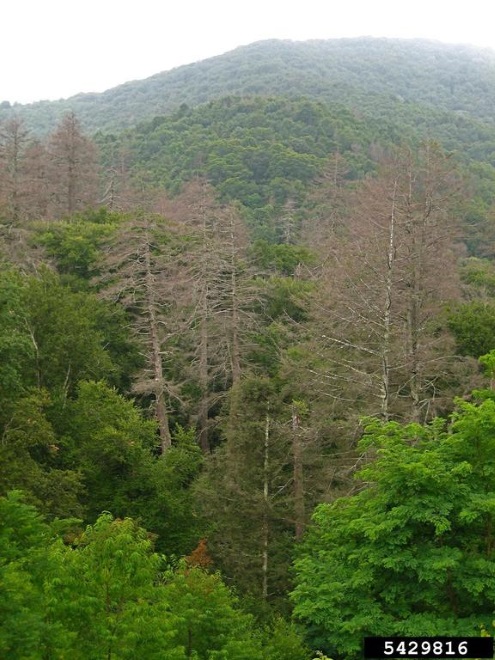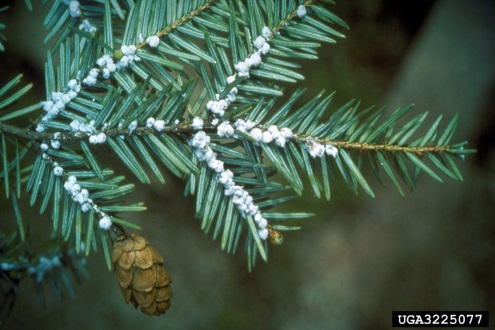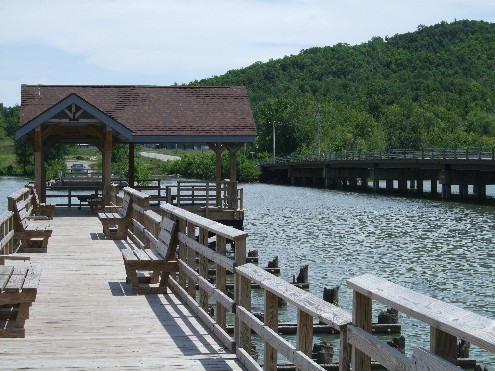
A damaged hemlock forest caused by hemlock woolly adelgid (HWA). (Jason VanDriesche Bugwood.org)
We sometimes take our trees for granted, but there is one that we need to start paying closer attention to now, before it joins the American chestnut in history books.
The Eastern hemlock is one of the most abundant trees in New York and a major component of the forests here in the Lake George watershed. It is an iconic part of the area, visible in nearly every corner of the watershed. They stabilize streambanks and shorelines, protect water quality of the streams that flow into the lake, and provide major economic value to the local timber industry.
The hemlock woolly adelgid (HWA) is a terrestrial invasive insect native to East Asia that attacks hemlock trees and has been killing large swaths of hemlock forest from the Great Smokey Mountains to the Catskills since first discovered in the 1980’s. The pest spreads primarily by “hitch-hiking” on birds and other animals, and has been making its way north to the Adirondacks; just last summer a very small population was found on Prospect Mountain in Lake George. Extreme cold has been found to help slow its spread and reduce populations, but is still unable to completely do away with the threat of HWA.
Once HWA is discovered, insecticides can be used to treat infected trees, but this can be a costly and labor-intensive process, and its success depends on early detection. Alternatively, biological controls are being developed, including beetles and flies that are natural predators of the HWA, though creating populations large enough to make a difference will take time.
The Lake George Land Conservancy (LGLC) is on the frontline facing the HWA threat here in the Lake George watershed. When the HWA was discovered on Prospect Mountain in 2017, LGLC staff worked side by side with the Adirondack Park Invasive Plant Program (APIPP) and NYS Department of Environmental Conservation (DEC) to survey the area around the infected trees for signs of additional HWA infestation, and also assisted with the treatment work on the infected trees.
In October, the LGLC was part of a community workshop in Hague put together by town officials and discussed the issue along with APIPP, the Adirondack Mountain Club (ADK), and Professor Mark Whitmore of Cornell University, a leading authority on HWA. Professor Whitmore is working to develop the bio-control that may help to manage the HWA infestation in the future. The LGLC hopes to work with other local partners, including the Fund for Lake George, Lake George Association, and towns around the lake to host additional workshops for municipal leaders as well as residents and other community members. The LGLC is also working with the S.A.V.E. Lake George partnership to raise awareness and seek funding for efforts to address this major threat to the watershed.
As one of the largest landowners within the watershed, the LGLC is being pro-active in its efforts to meet the challenge of the HWA on its own land. This winter, their land steward has begun surveying its preserves and checking hemlocks for the invasive pest. Focus is put on critical stands along stream corridors and wetlands.

HWA infestations can be most noticeably detected by the small, white, woolly masses produced by the insects that are attached to the underside of the twig, near the base of the needles.
Volunteers are also being trained in what to look for and how to report their surveys of trails and other lands. All of these surveys and any possible findings are then uploaded to iMapInvasives, a collaborative, state-wide online invasive species database and mapping system that is accessible to the public.
The scope of this early detection work is enormous, and volunteer help is crucial. The LGLC plans on continuing its partnerships with ADK and APIPP to host and support additional training workshops, to increase the number of volunteer “citizen” monitors. With this additional help, once the LGLC monitors the 4,200 acres that it owns and holds conservation easements on, it will be able to expand efforts to monitor the 3,200 acres that the LGLC manages for the DEC, and possibly other DEC land as well (with permission).
In the event that HWA is discovered on its own land, the LGLC is prepared. By the end of this winter, its staff will have the necessary credentials to apply the treatments to infected trees and the surrounding area. The LGLC cannot treat private lands or DEC land, but will alert its partners if any HWA outbreaks are found there. It is also looking into ways to provide habitat for the biocontrol predators, as well as cones and stock for hemlocks so that if an outbreak occurs on protected land, new hemlocks can be grown to replace those that die.
The HWA is a challenging threat to Lake George’s hemlock forests, as evidenced by its impact on the Smokey Mountains and Catskills, but the LGLC is a formidable force in Lake George’s defense. To date, the organization has spent approximately 1,500 hours of staff time on outreach, research, training, and on the ground monitoring to battle this invasive, at a cost of $75,000. We won’t be able to check every hemlock, or entirely stop it from coming, but by preparing now, we can lessen its impact and help our native hemlocks continue to be an icon for generations to come.
 Two school board seats will be up for election in 2018. School board President, Frank Barber’s term expires, making a three-year term available. The seat formerly occupied by Jason Hoagland, who resigned before completing his term, will come up for election as a one-year term. Petitions of those seeking these seats must be returned to the district clerk by April 16th no later than 5:00 pm. To run, a person needs to be 18 years old by May 15th, must have resided in the school district for at least a year, and must submit a petition signed by 25 eligible voters.
Two school board seats will be up for election in 2018. School board President, Frank Barber’s term expires, making a three-year term available. The seat formerly occupied by Jason Hoagland, who resigned before completing his term, will come up for election as a one-year term. Petitions of those seeking these seats must be returned to the district clerk by April 16th no later than 5:00 pm. To run, a person needs to be 18 years old by May 15th, must have resided in the school district for at least a year, and must submit a petition signed by 25 eligible voters.


